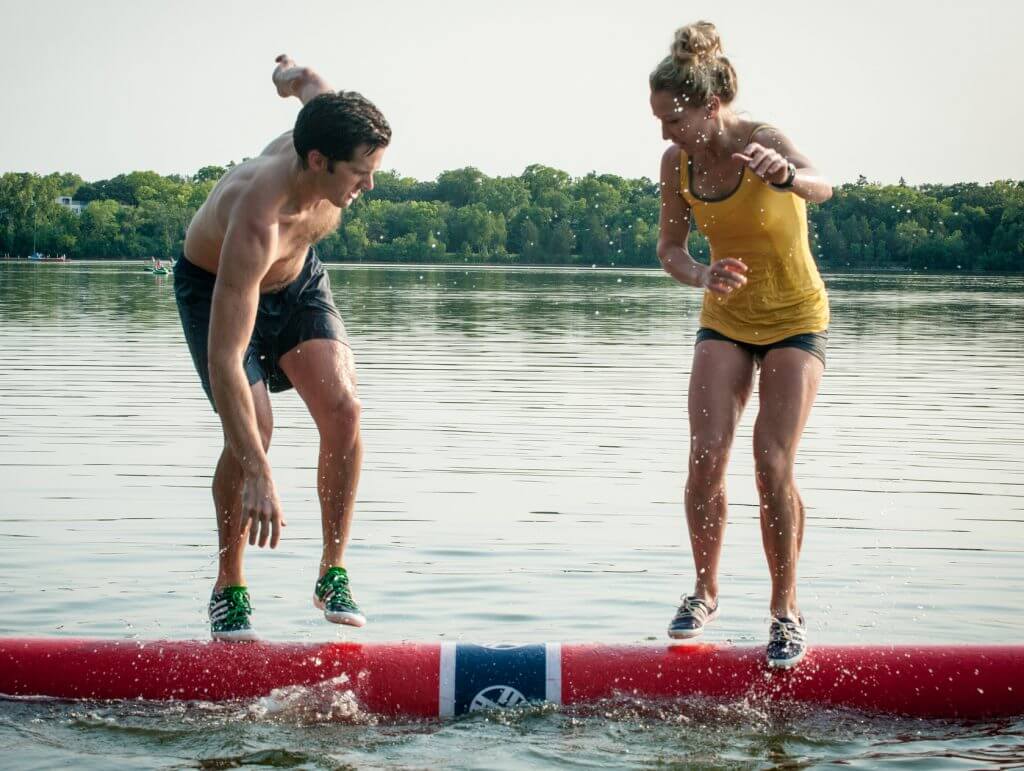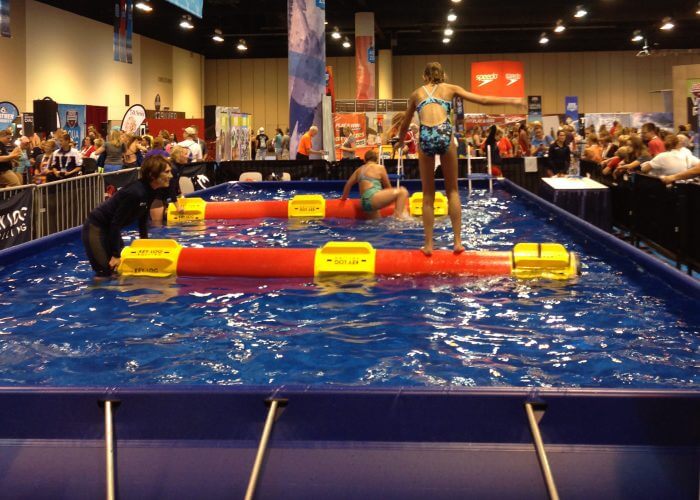Log Rolling: From Lumberjack Game to Aspiring Olympic Sport

By Annie Grevers, Swimming World Staff Writer
If you were fortunate enough to attend the U.S. Olympic Swimming Trials in Omaha, Nebraska this summer, you may have come across a curious display in the lively Aqua Zone area. A small above ground pool was set up in the center of the massive zone of swimming-crazed fans. In the pool? Not swimmers, not surfboards, but synthetic logs.

Photo Courtesy: Annie Grevers
Allow me to introduce you to log rolling. Yes, it’s a sport. And it’s been around longer than you might think. The first World Log Rolling Championships were held in Omaha, Nebraska in 1898. Log rolling’s history begins with men driving logs down the river “highway system” at the turn of the century. In the evenings, the guys at the lumber camps would challenge each other to see who could stay atop a log for the longest duration.
What exactly is log rolling? Well, it’s really better explained by video than by words:
One family has been leading the charge in expanding the sport they describe as a “primal balance challenge.”
Judy Scheer grew up in Hayward, Wisconsin– a lumber town that has long played host to the World Log Rolling and Lumberjack Championships. She was 12 years old when she took her first log rolling class in 1969. In a pre-Title IX era, Scheer had very few athletic options, so when she found the challenging sport of log rolling, she was hooked.
Scheer won her first world title in log rolling in 1972 at the age of 16. Her coach, Jay Hoeschler, had moved to Hayward to work as the tennis pro before testing the waters of log rolling. The 18-year-old learned he was better at instructing and encouraging than balancing…and there was one student he was especially keen on working with. Scheer and Hoeschler found perfect balance with each other. They shipped off to Boulder, Colorado for college and were married after graduation.
Scheer’s passion for log rolling didn’t die when she moved south. The Wisconsin girl brought a 500-pound cedar log with her to college and convinced the local recreation center to allow her to plop it in the pool. Judy taught her friends and trained for competitions. She would end her log rolling career with seven world championship titles.
Rolling As A Family
After college, Judy and Jay moved back to Wisconsin to start a business and a family. Judy’s passion for teaching only grew. She brought logs to the local YMCA pool, where she taught all four of her children to log roll.
“My sister and I remember learning how to ride a bike, but not how to log roll. We were young enough to not remember!” Judy and Jay’s daughter Abby Hoeschler said about her early introduction to the sport.
Judy had used wooden logs with spike shoes for her log rolling. But the spikes shredded the wood, and the local YMCA wasn’t about to allow spiked shoes in their pool.
Enter Hoeschler Innovation #1: carpet-wrapped logs. Judy discovered a water-shedding carpet made from Olefin, which offered perfect traction with rubber-soled shoes. This innovation made log rolling more accessible. The Hoeschlers hoped the sport would begin to gain as much traction as their quick feet on a perpetually moving log.
Log rolling is a family affair for the Hoeschlers. The three Hoeschler sisters have amassed many world titles in log rolling, and their younger brother has collected four world titles in the boom run.
Though log rolling may look like a frivolous exercise, there’s nothing easy about the sport. Abby emphasizes the importance of core strength, fast twitch muscle development, aerobic capacity and extreme body control. “When you’re trying to recover from almost falling off a log, you’re fighting against a 500 pounds of mass,” she says. “You can’t ever take a break in log rolling– if you stop for a second you’re in the water. Your heart rate gets up really fast.”
Revolutionizing the Sport
I went out to school on the East Coast,” Abby said. “I saw people were really intrigued by log rolling– they loved learning, they just didn’t have access.”
Those cumbersome logs were making growth in the sport nearly impossible. So Abby’s wheels started turning…
“We had this idea for a lightweight synthetic log. We really want log rolling to be in the Olympics,” she said. For log rolling to become an Olympic sport, a few things needs to happen. The most important being: there needs to be more growth internationally.
“We can’t ship cedar logs outside of the US because of agricultural restrictions,” Abby said. “We needed to come up with a lightweight, portable product.”
In a serendipitous encounter on a hike, Abby met two engineering students. An art history major, Abby knew she needed science-minded people to bring her idea to fruition.
Abby and the student engineers came up with a design. The log would be made from high density polyethylene– the same material used to make plastic kayaks. The interior is a polystyrene foam– something you simply add water to in order to give the synthetic log the same mass as a wood log.
Enter Hoeschler Innovation #2: The Key Log.
“The first time I tried the prototype (in 2011), we walked it down to the lake and I was thinking ‘There’s no way it’s going to work/feel the same as a cedar log.'”
Abby gave it a test drive and was amazed by how not synthetic the log beneath her felt.
The Hoeschler family sees the Key Log as a huge leap toward getting their sport on the international stage. So what are the necessary steps to get log rolling in the Olympic Games?
“First we have to start more programs internationally. We’ll be forming an international governing body for the sport. It can become an IOC-recognized sport without being in the Olympics,” Abby said. “Then it’s building tournaments, building up participation.”
The Hoeschlers plan on putting on the first collegiate log rolling championships in two years– there are currently 80 college log rolling programs in the US.
Have you rolled a log today? Maybe it’s time you try…there may be coming a day you could be log rolling for Team USA.





Today Amir and Imaad will show their full talent, Watch Pakistan VS England 1st ODI 24 August 2016
Thirty-two athletes competed at the Professional Lumberjack Competition in Boiestown, N.B., Saturday, drawing hundreds of spectators from as far away as France for events including the vertical chop, crosscut saw, axe throw and log rolling.
The annual event hosted by the Woodmen’s Museum is in its fifth consecutive year and organizer Darren Colford says it’s their biggest one yet.